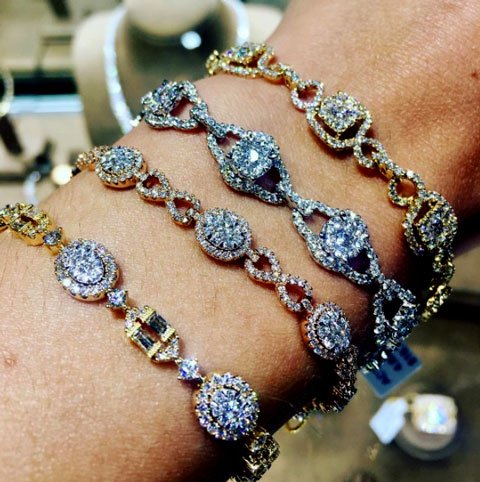The Las Vegas jewelry show season injected some confidence back into the diamond trade, despite a drop in attendance. Beyond the trading prospects for buyers and suppliers, last week’s shows provided a snapshot of the diamond and jewelry market.
Many observers found the market in a better position than it was a year ago – despite its lingering challenges.
Here are the underlying factors currently influencing the market:
Las Vegas Jewelry Show – 1st learning – Trading Stable but No Urgency to Buy
The market is functioning, and there is some confidence in US demand. Significantly, jewelers are adapting to shifts in consumer trends more than they were a year ago.
Savvy jewelers are developing omni-channel capabilities with social-media strategies in place, and are providing bespoke, customized services and products, which will carve their position in the market. Those that aren’t taking these steps are falling by the wayside.
However, the retail environment is still volatile and evolving. A drop in sales at Signet Jewelers and Tiffany & Co. has raised concerns about the majors, while the “mom-and-pop” independent segment continues to shrink, adding to the uncertainty.
“The market is OK, but it’s not totally robust,” said Stanley Zale, vice president of diamonds and gemstones at Stuller, a large jewelry wholesaler and distributor. “The old business model doesn’t work anymore, as jewelers have shifted from being inventory-heavy to operating more efficiently.”
They certainly weren’t looking to build up inventory at the show. A number of diamantaires noted that buyers were looking for goods but weren’t spending their full budgets. Buyers were looking for a narrower range of diamonds, demonstrating good demand for better-quality H- to J-color, SI-clarity diamonds – which weren’t always readily available.
Buyers are also shifting to lower price points, willing to compromise on size within that H to J, SI category range, which reflected consumers’ tighter spending in the current US economic environment, explained Charles Rosario, vice president at New York-based supplier Lazare Kaplan.
“Retailers are adjusting to middle-income consumers who are still finding their footing and will buy at lower price points,” Rosario explained. “It’s not about margin, it’s about survival.”
Edahn Golan, an independent analyst working with NDP Group, which provides data analytics about the retail sector, estimated that average retail prices for diamonds softened by 1% in 2016.

Las Vegas Jewelry Show – 2nd learning – Suppliers Stuck with Inventory
Retailers are trying to protect their profit margins by passing that price reduction onto wholesalers and diamantaires, who are under pressure to generate cash flow. Golan added that average wholesale prices dropped 2% last year.
Diamond suppliers particularly feel squeezed when working with the major retailers, expressing reluctance to adhere to their “dictated terms and conditions,” as one manufacturer experienced.
“The glory of selling volume to one guy sounds easier because you get consistency,” Rosario explained. “But they beat the hell out of you, so why sell if you can’t make money?”
Manufacturers’ profit margins are narrowing as they feel the squeeze from retail buyers, while having to pay for rough “that’s slowly rising in price each month,” added an Israel-based manufacturer.
Furthermore, since jewelry wholesalers and retailers are being picky, diamond dealers and manufacturers are left holding the bulk of the industry’s inventory. Another Israel-based exhibitor said he had built his business model around presenting a large stock of diamonds to choose from, especially since retailers generally want to take goods on memo.
“It suits me perfectly, as I don’t have to worry about retailers’ liquidity, because they take the diamond on memo and pay for it when they sell,” he said, requesting anonymity.
However, most small-to-medium-size diamond businesses cannot afford to finance the stone while it’s out on memo, and diamantaires generally try to avoid being stuck with too much inventory. There was some discounting at the show in an effort to offload excess old stock, but US jewelers are not buying for stock even at reduced prices, another New York-based supplier stressed.
Many said inventory levels were in balance for now, even suggesting there were shortages of those popular SI-clarity goods. But they’re concerned that new polished supply will hit the market, as manufacturing has increased over the past few months, raising stock levels in the midstream during the quiet summer period.

Las Vegas Jewelry Show – 3d learning – Change Is the Only Constant
Some manufacturers expect the range of demand to widen later in the year as jewelers start to think about Christmas. But they also noted that June was too early for jewelers to buy for the holiday season, as the market has been changing at such a rapid pace.
Change is being driven by evolving consumer-buying habits – affecting how, what, why and where people buy – and the fact that millennials are relating to diamonds differently than previous generations. This is forcing retailers to rethink the way they interact with their customers and causing marketers to reinvent the way they tell the diamond story.
Meshing baby-boomers’ gemological know-how with millennials’ tech ability is where the real opportunity lies.
Millennials may be different, but like generation X-ers and baby boomers, they need to trust their jeweler. And a large part of that trust is demonstrated and earned online through a jeweler’s website – and perhaps more importantly, its social media presence. Consumers are increasingly “window shopping” online before purchasing, and they’re consequently more knowledgeable and empowered to pressure the retailer into lower price points.
It’s then up to jewelers to show the added value that makes them stand out from the crowd to enable the sale.

Las Vegas Jewelry Show – 4th learning – Adding Value Through Customization
Jewelers need to differentiate themselves, as millennials want their jewelry to reflect their individuality. This is forcing retailers to provide more options for their customers, particularly as they offer bespoke jewelry-building tools on their websites.
Innovation among jewelry wholesalers to enable that customization was evident at the show. Suppliers presented different options for their designs, varying the metal type and weight, or the size of the piece, and showcasing them in various settings.
Service providers have also recognized that they can help jewelers enrich the experience they offer, largely using technology.
These opportunities provide retailers with an avenue to enhance their own brand, whereas their branding efforts are too often overshadowed by those of their wholesale suppliers, noted Russell Fyfe, chief operating officer of RingCam, which provides retailers with a tool to fit a camera in a ring box to record the gift-giving moment.
Retailers are seeing greater branding opportunities as they try to woo customers with their story and the unique jewelry-purchasing experience they provide.

Las Vegas Jewelry Show – 5th learning – No Business in Show Business?
Trade show organizers also need to demonstrate their added value, and many diamantaires questioned the benefit of participating in “an expensive show” when visitor traffic was noticeably down.
“It doesn’t do our brand any good when people see an empty booth,” said an Israel-based exhibitor.
Many blamed the lower traffic on the organizers’ decision to hold the show during the week, meaning that they missed the weekend traffic. Next year’s JCK show has been set for a weekend. Nonetheless, buyer attendance at shows – not just in Las Vegas – has diminished in the past few years.
It is also worth noting that the diamond section at a trade show can be overwhelming at times, with booth after booth of diamonds and certificates on display. It’s difficult to pick up stray buyers roaming the halls when all the exhibits look the same.
For a successful show, suppliers needed to prepare with pre-set appointments and find a way to differentiate their display, and – not to belabor the point – demonstrate the added-value service they can provide their clients.
Those who did so left Las Vegas with a positive feeling about the market, because there were serious buyers at the show.
Therefore, there’s still a sense that, as a supplier, you have to be in Las Vegas at the beginning of June.
“Otherwise the sale will go somewhere else,” Rosario said. “The show is an opportunity to make appointments, see clients and get a sense of the market. It’s a necessary evil.”
What was you impression of the Las Vegas Jewelry Show ?

Sylvain Goldberg – on the Las Vegas jewelry show







